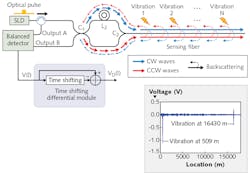Vibration Monitoring: Distributed fiber-optic vibration sensor uses low-cost interferometry and OTDR
Fiber-optic sensors that measure distributed vibration along a length have myriad applications, including oil and gas pipeline monitoring, border security, and structural integrity monitoring for bridges, aircraft, and other critical infrastructures.
Because vibration induces a phase change in the optical signal reflected back from an optical fiber, interferometers are commonly used in low-cost distributed optical fiber vibration sensor (DOFVS) measurement setups; unfortunately, these interferometer-only setups cannot distinguish between simultaneous multi-point vibrations, limiting their utility.
And although phase-sensitive optical time-domain reflectometry (F-OTDR) can distinguish multi-point vibrations with high sensitivity (and can be further improved by coherent detection, modulated pulses, and optical amplification), the ultranarrow-linewidth, powerful lasers required for these systems are not only expensive, but subject to instability including Rayleigh scattering and frequency drift.
To address the drawbacks of each of these methods, researchers at Huawei Technologies (Shenzhen, China), Southeast University (Nanjing, China), and Northeastern University (Shenyang, China) have developed a real-time DOFVS that uses the principles of Sagnac interference and coherent OTDR technology, requiring only a low-cost broadband superluminescent diode (SLD) to achieve 16 km range with 110 m spatial resolution and ± 0.5 m location error with longer averaging.1
Sagnac coherent OTDR
In the setup, the 35 mW, 1550 nm center wavelength and 40 nm bandwidth SLD source reduces the noise caused by the coherent interaction of Rayleigh backscattering signals from different scattering points in the fiber. Light from the SLD enters a directional coupler and is split into two paths, one having a delay fiber, before re-combining in a second coupler connected to the length of optical fiber intended to gather vibration information (see figure).
Light reflected back from the optical fiber because of the presence of vibration, strain, or temperature events can pass back through both arms of the interferometer and into a balanced detector, which also sees a portion of the SLD input as a reference signal.
A series of mathematical equations sees vibration as a phase change in the interference signals of the interferometer and both single-point and multi-point vibrations can be calculated from the reflectance data.
The keystone of the measurement system is a time-shifting differential module that converts the abrupt vibration-induced signal intensity changes to an electronic pulse that can identify vibration intensity and location along the fiber. Experimental measurements of piezoelectric-transducer (PZT) vibration sources demonstrate a sensing range of 16 km for the 35 mW SLD source in a setup with much lower cost than commercial F-OTDR systems.
REFERENCE
1. C. Pan et al., Opt. Express, 25, 17, 20056–20070 (2017).
About the Author

Gail Overton
Senior Editor (2004-2020)
Gail has more than 30 years of engineering, marketing, product management, and editorial experience in the photonics and optical communications industry. Before joining the staff at Laser Focus World in 2004, she held many product management and product marketing roles in the fiber-optics industry, most notably at Hughes (El Segundo, CA), GTE Labs (Waltham, MA), Corning (Corning, NY), Photon Kinetics (Beaverton, OR), and Newport Corporation (Irvine, CA). During her marketing career, Gail published articles in WDM Solutions and Sensors magazine and traveled internationally to conduct product and sales training. Gail received her BS degree in physics, with an emphasis in optics, from San Diego State University in San Diego, CA in May 1986.
